Hays joins Comal and Williamson counties as a powerful triumvirate of suburbs around Travis County and Austin itself. The Austin area is the most dynamic in the United States, attracting scientists, artists, musicians, and people of every stripe. With San Marcos at its core, Hays County is young, hip, and quickly becoming one of the most in-demand places to live and work. But there is a downside to all of the people, money, and businesses flowing into the community, and that is property taxes.
As Hays County keeps rising in prestige, the value of properties has been reaching record highs. As both homes and businesses are driven to unaffordable levels, residents are looking for a way to stem the tide. Property tax appeals are quickly becoming the best and only option to set things right. The use of property tax appeals in Hays County has grown every year, and over 34% of all property was protested as of 2023. This certainly returned results and taxpayers across the county were able to fight the worst of the values put forward by the Hays Central Appraisal District (Hays CAD). In this article, we will look at how these protests helped taxpayers, as well as how those that partnered with O’Connor fared.
Appeals Reduce Millions in Value for Homeowners
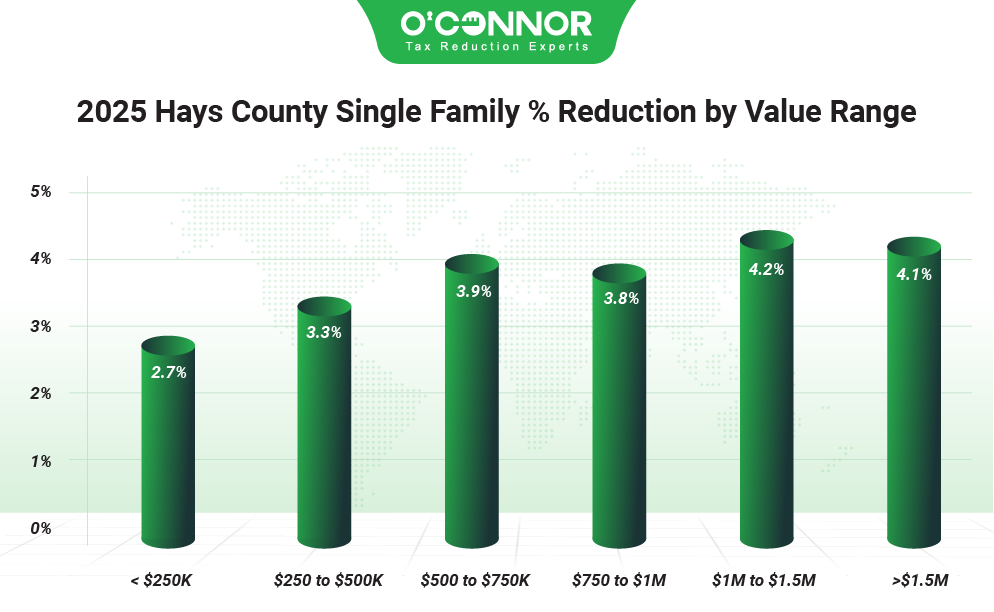
Single family homes added 5% to their value in 2025, yet another increase in a trend of surging costs. To top it all off, Hays CAD believed that 42% of all homes were overvalued, which only added to the pain felt by homeowners. This led to a total of $44.68 billion for all residential properties. Appeals did prove their worth, however, and 3.7% of the total was reduced. It was homes worth between $250,000 and $500,000 that produced the most value, with $15.82 billion in value after a moderate cut of 3.3%. Those assessed from $500,000 to $750,000 were No. 2 with $8.45 billion after a decrease of 3.9%. The rest of the totals were pretty evenly split, along with the reductions. The only exception was homes worth less than $250,000, which accounted for only $1.23 billion, with a reduction of 2.7%. When homeowners chose to work with O’Connor, they were able to save 6.1% on the combined total value, including a large 6.1% cut for homes worth between $250,000 and $500,000.
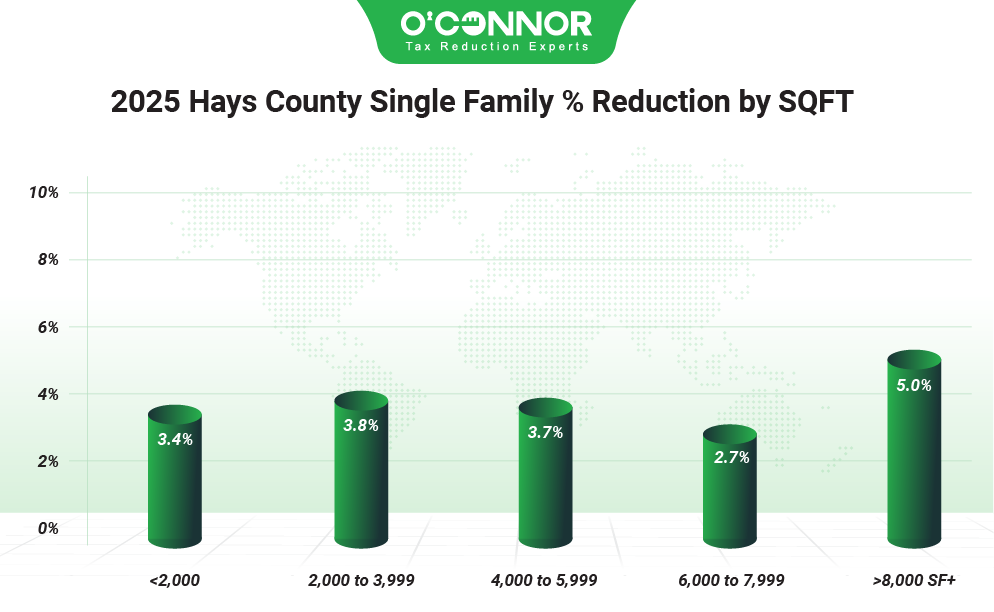
Sharing another similarity to Williamson County, Hays was loaded with high-dollar homes, but these were not giants for the most part. In fact, most of the value came from residences between 2,000 and 3,999 square feet, which had a combined total of $24.22 billion. Homes under 2,000 square feet ranked the next in value with $14.57 billion after a reduction of 3.4% thanks to appeals. Those at 4,000 to 5,999 square feet added $3.28 billion to the overall value, even after a reduction of 3.7%. The two largest home categories were only valued at $505.09 million and $463.98 million respectively, with cuts of 2.7% and 5%. O’Connor was able to improve on all these numbers, including a 6.4% reduction for homes sized between 2,000 and 3,999 square feet.
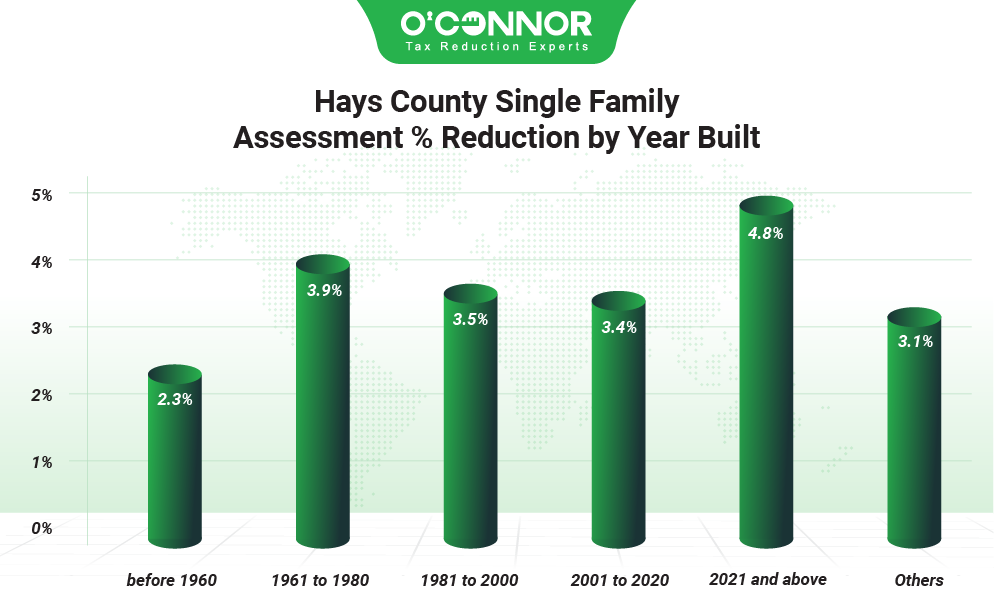
Like much of the Austin area, Hays County experienced a large building boom between 2001 and 2020. 51.4% of all home value was built in this timeframe, totaling $22.11 billion, even after a solid reduction of 3.4%. Illustrating how quickly Hays County is changing, new construction was responsible for 19.9% of value in 2025, totaling $8.58 billion, even after a cut of 4.8%. The third-largest timeframe was for those built between 1981 and 2000, which resulted in a sum of $8.04 billion. Showing the untapped potential of Hays County, even raw land managed a total of $2.46 billion, classified as “other” on the chart.
9.6% of Commercial Property Value was Shed Thanks to O’Connor
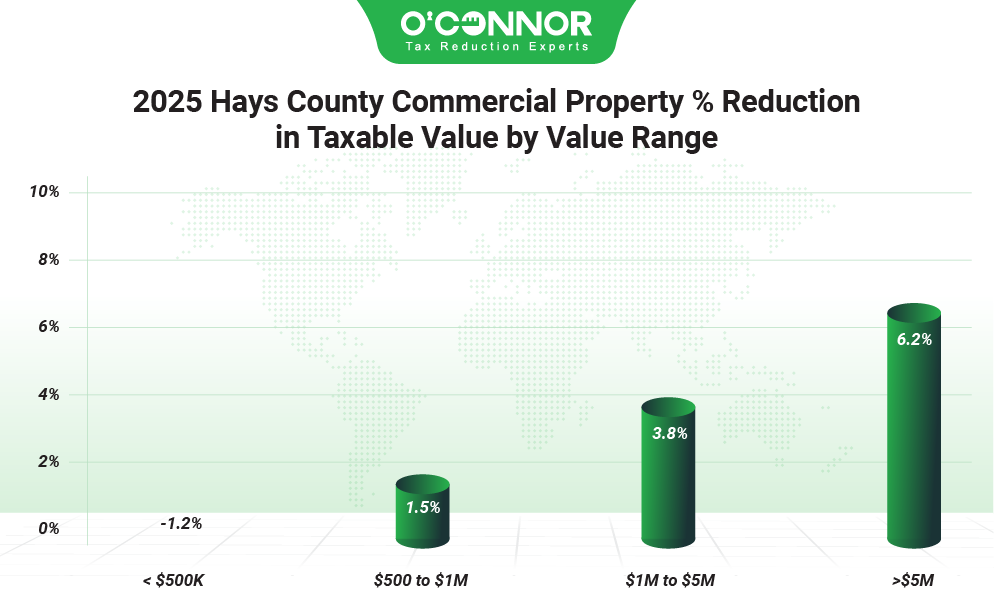
While not a commercial hub, Hays County still has a growing business real estate market, and it is rapidly swelling in value. In 2025, commercial property added 4.4% in value to the total, after a surge of over 10% in 2024. All commercial property was assessed at $9.22 billion in 2025, but this was quickly shrunk by 4.4% thanks to dedicated appeals. Commercial properties worth over $5 million generated $3.85 billion in value, which was after a strong reduction of 6.2%. Business real estate worth between $1 million and $5 million was close behind with $3.63 billion, after a cut of 3.8%. This is a rare situation in Texas, as usually the most expensive commercial properties are responsible for 50% of the total or more. Clients that used O’Connor for their commercial appeals saved 9.6% on their combined total, including 11% for properties worth over $5 million.
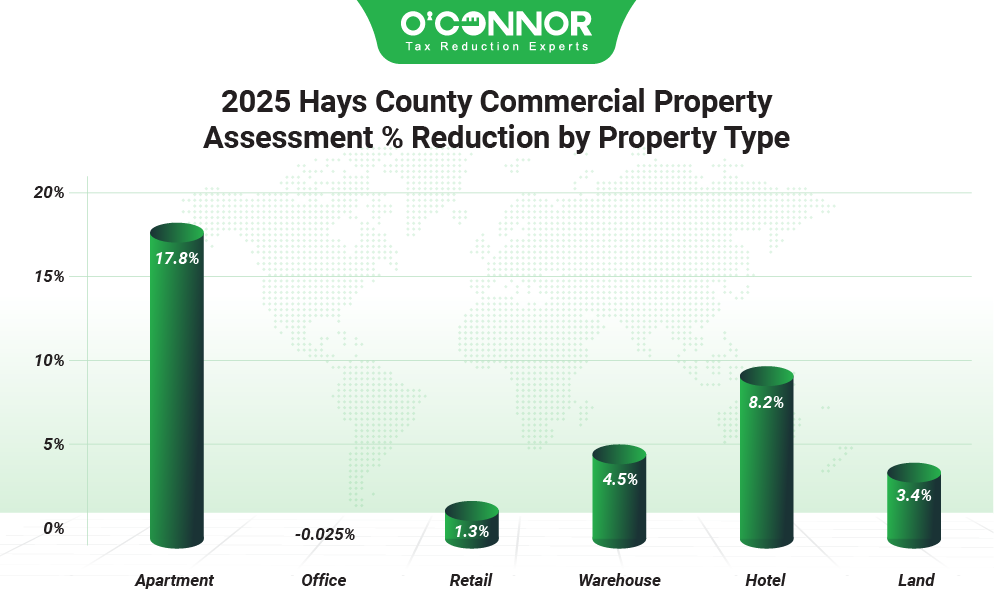
Hays County bucked another trend when it came to commercial property thanks to raw land being the most valuable of all. Hays CAD accessed undeveloped land at $5.63 billion, which was later protested down by 3.4%. Warehouses, usually lower on the totem pole, came in at No. 2 with $1.04 billion in value after a cut of 3.5%. Apartments, usually the most valuable in a suburban environment, came in third with $617.97 million after a huge reduction of 17.8%. Offices failed to show any measurable decrease, while hotels got a solid cut of 8.2%. Retail experienced only a trimming of 1.3%, leading to a total of $895.66 million.
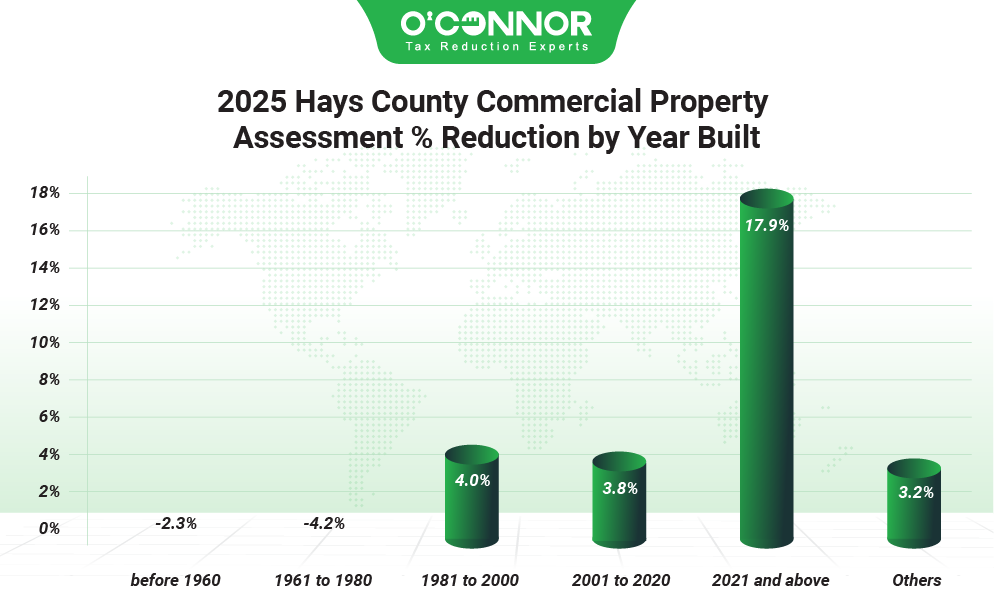
Unlike homes, commercial property only had one real boom period. About 21.7%, or $1.99 billion, was built between 2001 and 2020. This received a trimming of 3.8% thanks to appeals. 64.2% of all assessed value was for raw land and those properties currently under construction. Those built between 1981 and 2000 were in third place with $609.91 million after a reduction of 4%. New construction was close behind, and had the lead with $672.61 million, before a gigantic slice of 17.9% dropped it to $552.25 million. O’Connor helped clients improve on all these numbers, including a staggering 28.6% reduction for new construction. No matter the era, we were able to help our clients save a combined value of $18.14 million.
O’Connor Helps Lower Office Values by 16.8%
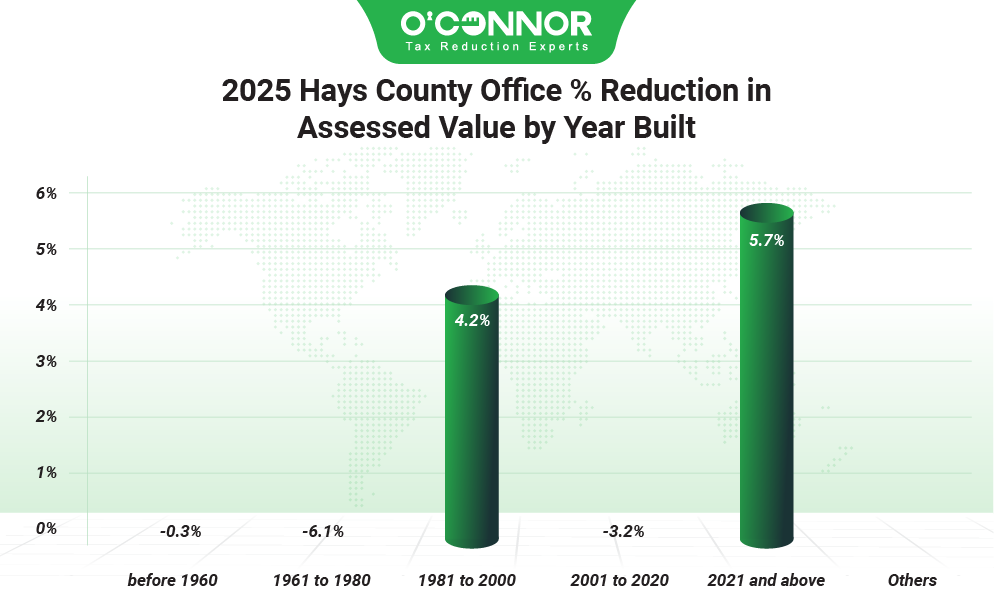
Offices were certainly an odd duck when it came to taxable value. Only two timeframes experienced decreases, while the rest saw increases. Offices had already seen decreases in taxable value during assessments, making these increases corrections by Hays CAD. The largest block of value was built between 2001 and 2020, which totaled $351.66 million. New construction saw a meteoric rise to become 20.5% of all office value, even after a strong appeal decrease of 5.7%. Those built from 1981 to 2000 managed a reduction of 4.2%, totaling $94.14 million. O’Connor managed to blow all of the county numbers away. While the county showed no gain or loss, O’Connor clients saw their combined total cut by 16.8%. This includes 21% for new construction and 18.2% for those built from 2001 to 2020. Our clients shaved $2.11 million from their office properties.
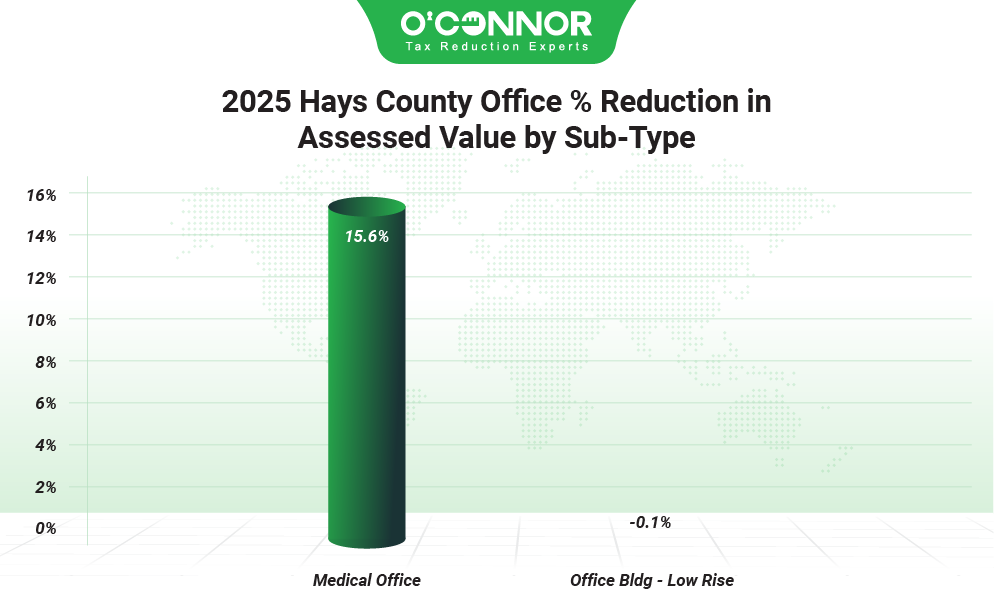
Hays CAD separated offices into just two categories. Low-rise office buildings were the largest block by far, totaling $581.42 million after an increase of 0.1%. Medical offices were much smaller at $3.295 million but did land a reduction of 15.6%. O’Connor represented all medical offices that protested in 2025, while also netting our low-rise clients a reduction of 17.3%.
Taxable Retail Value Reduced 15.1%
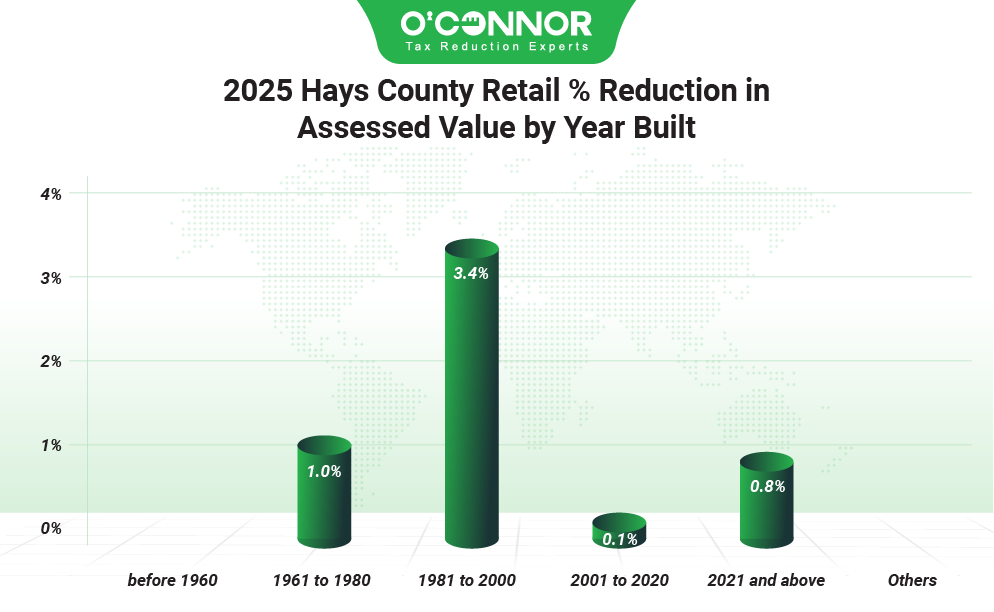
While retail had a small total of $907.80 million, below that of apartments, land, and warehouses, it was still a vital chunk of the economy of Hays County. The established pattern of construction timeframes continued, with 50.9%, or $456.19 million in value being built between 2001 and 2020. This would eventually be lowered by 0.1%. A larger cut of 3.4% was seen by those built from 1981 to 2000, which resulted in $301.97 million. New construction was already responsible for 13.1% of the total and reached $11.49 million with a small reduction of 0.8%. O’Connor landed much bigger reductions for our clients, with their combined total being reduced by 15.1%. New construction was hit with a mighty slice of 22.9% alone.
Warehouses Trim Value by 9.7%
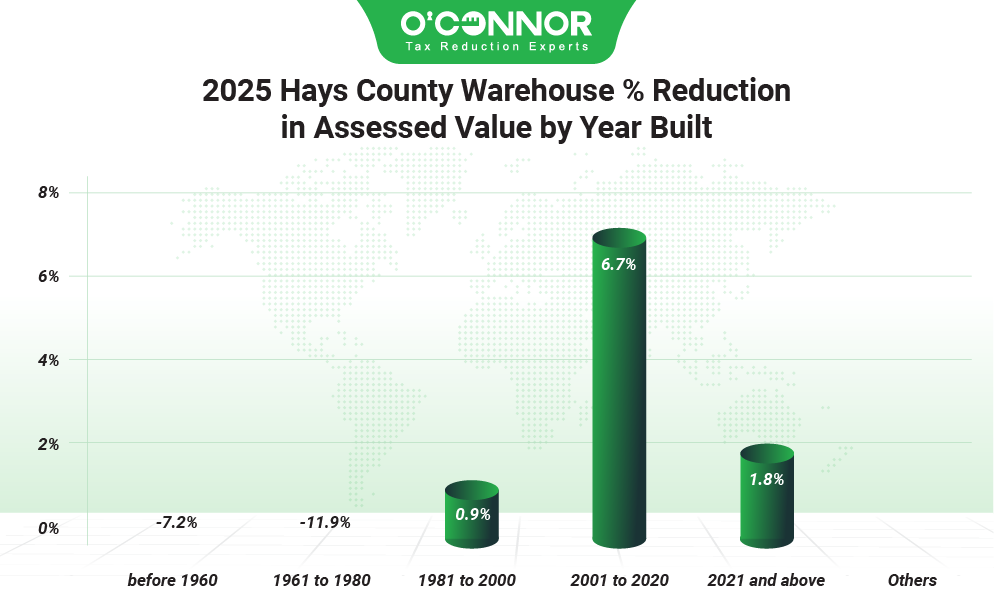
Warehouses were a surprisingly large contributor to the economy of Hays County. While vital to any county, these storage icons managed to take second place with a combined total of $1.09 billion. This was eventually lowered to $1.04 billion after a concerted appeal effort, which basically wiped out the previous increase of 4.6%. Like all other property types, most of the value was built between 2001 and 2020, with $608.58 million being from this timeframe after a cut of 6.7%. New construction accounted for 25.3% of all value, which translated to $262.79 million after a small reduction of 1.8%. Those built between 1981 and 2000 rounded things out with $149.48 million, which followed a decrease of 0.9%. We at O’Connor did well for your warehouse clients, nabbing a reduction of 9.7% to the overall value. The biggest reduction we achieved was 9.9% for those built from 2001 to 2020.
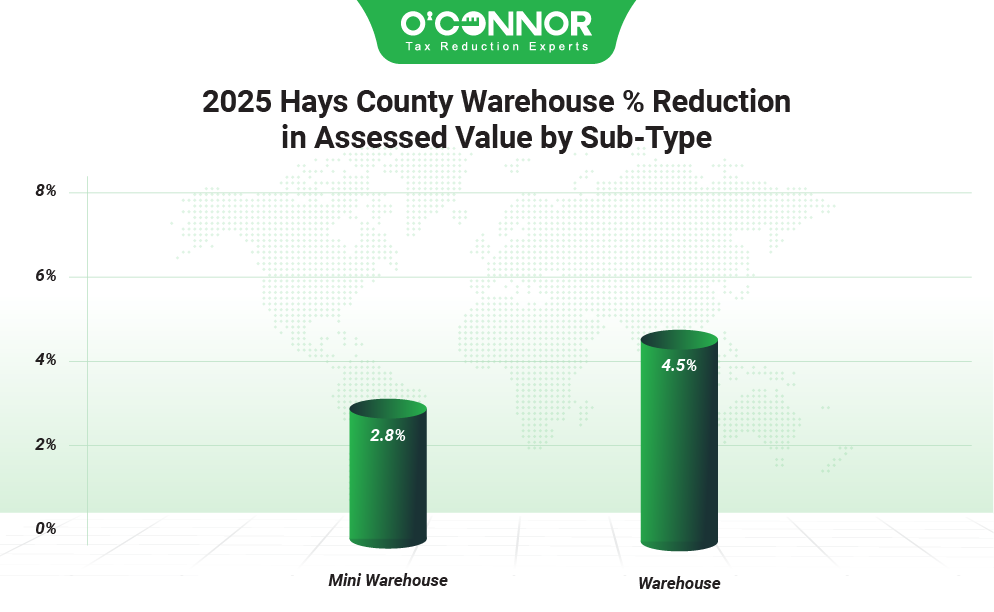
Hays CAD did not exactly do a deep dive into warehouses, only classifying them as either mini warehouses or generic warehouses. Being, well, generic, standard warehouses were responsible for a lion’s share of the value, producing $1.04 billion after a solid drop of 4.5%. Mini warehouses lived up to their name, only being accountable for $325 million, after a decrease of 2.8%. At O’Connor we’re solely responsible for all mini warehouse appeals, while our generic warehouse appeals saved 9.9%, doubling the county number.
Property Tax Appeals Payoff for all Participants
Taxpayers in Hays County have certainly not bowed to Hays CAD and their overvalued numbers. With over one third of all properties being protested each year, Hays CAD must mind their values to ensure that they are always within a fair margin. Even though appeals did not bring home a slew of savings like in other counties, they were still successful, and it looks like maybe Hays CAD is finally starting to hand out realistic numbers. This does not mean taxpayers can rest, however, and constant vigilance is needed. Hays County should be held up as a great example of how well protests can work when the community comes together.
Those that chose O’Connor saw better results than the typical county numbers. About 6.1%, or $50.25 million in taxable value was saved for homes, while businesses were able to claw back $18.18 million, or 9.6%. In categories like offices, we were able to eclipse the county numbers by several orders of magnitude. We were even responsible for entire categories all on our lonesome. We take great pride in helping our clients and value having working partnerships with them, as it takes both of us to truly prosper. If you are looking to join us, know that there is never any cost to enroll. On top of that, we will also protest your taxes every year, establishing a base value that can be defended for years to come. You will only pay if we can lower your taxes, and we will never ask for a cent otherwise.

